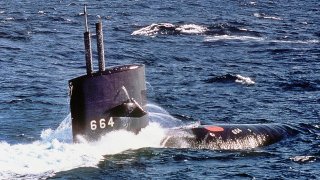The U.S. Navy’s Sturgeon-class Submarine: An Experiment Gone Right
Sturgeon-class submarines had four 21-inch torpedo tubes and a wide variety of weapons to choose from. Among them were the Mk 48 torpedo, Harpoon anti-ship missile, and eventually the Tomahawk cruise missile.
The U.S. Navy of the early Cold War went through some radical evolutions. Multiple variations of aircraft carriers were tested. Nuclear-powered submarines became the preferred form of undersea combatant for the U.S. Navy.
This was a time of extreme experimentation in preparing for the possibility of a total nuclear world war. The Navy had to be prepared to fight and win such a war.
Enter the Navy’s Sturgeon-class submarine, a landmark in submarine technology. Indeed, these subs provided the backbone of the undersea fleet for decades.
Some Background
First developed in the late 1960s as a follow-on to the old Permit-class submarines, the Navy saw these new boats as offering speed, stealth, and operational range its predecessors never could achieve. USS Sturgeon (SSN-637) was first commissioned in 1967. Its primary goal was to counteract the Soviet undersea threat and protect the Navy’s growing fleet of ballistic missile subs.
Sturgeon-class submarines came with a set of interesting capabilities. The Navy decided to incorporate anechoic tiles along with sophisticated noise-reducing technologies to enhance the stealth abilities of this boat. These capabilities made the Sturgeon class an excellent platform for covert intelligence operations.
Some Specs
Generally, Sturgeon-class boats were just shy of 300 feet long, with a beam of about 32 feet. These subs displaced 4,250 tons when submerged. They were made with HY-80 steel, which withstood greater pressures at depths previously unreached by U.S. Navy submarines. A single S5W or S5G nuclear reactor powered the Sturgeon class. With this technology, the submarine technically had unlimited range. The boat could travel faster than 20 knots (or 23 miles per hour) when submerged.
Sturgeon-class submarines had four 21-inch torpedo tubes and a wide variety of weapons to choose from. Among them were the Mk 48 torpedo, Harpoon anti-ship missile, and eventually the Tomahawk cruise missile.
Such a submarine could transition easily from anti-submarine to anti-surface warfare.
Not only did this class of sub offer enhanced stealth abilities and greater depths at longer ranges, but she came equipped with the BQQ-5 advanced sonar system. Sailors aboard could trust they had a decisive tactical advantage over any potential enemy underwater, because these subs could hear better and farther underwater than could the acoustic detection of their Soviet Red Navy enemies. Sturgeon-class sonar operators could much more easily detect supposedly quiet Soviet subs operating nearby.
Cultural Impact
The Sturgeon-class submarine left quite a legacy. It formed the basis for most future innovations in U.S. Navy submarine design.
These boats were significant for training the next generation of submariners as well. The long experience of operating these stealthy boats proved decisive for preparing future submariners for covert undersea warfare.
We all owe a debt of gratitude to the old Sturgeon-class submarine.
Author Experience and Expertise: Brandon J. Weichert
Brandon J. Weichert, a National Interest national security analyst, is a former Congressional staffer and geopolitical analyst who is a contributor at The Washington Times, the Asia Times, and The-Pipeline. He is the author of Winning Space: How America Remains a Superpower, Biohacked: China’s Race to Control Life, and The Shadow War: Iran’s Quest for Supremacy. His next book, A Disaster of Our Own Making: How the West Lost Ukraine, is due October 22 from Encounter Books. Weichert can be followed via Twitter @WeTheBrandon.
All images are Creative Commons or Shutterstock.
From the Vault
Russia Freaked Out: Why the U.S. Navy 'Unretired' the Iowa-Class Battleships
Battleship vs. Battlecruiser: Iowa-Class vs. Russia's Kirov-Class (Who Wins?)

